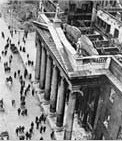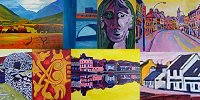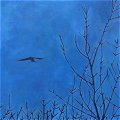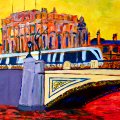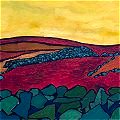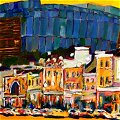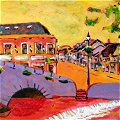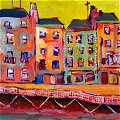Movement as Art
If you take away an accompanying narrative, are you still looking at art? Well, it’s not a pipe.
Some people walk their name in maps. That is, they take a street atlas, mark out their name, and then walk the route as mapped by the letters of their name. Are the marked maps art? Even without the explanation? And before or after the actual walking? Even without the walk, the performance?
When I walk Dublin’s streets, I see the walk as a drawing in my head. Does it matter if you don’t?
I’ve painted maps. Not on maps, but actually painted them from scratch. From memory, and they were emotional. But is the narrative of the emotion involved necessary for the map to be more than a map? Well, by mapping standards they were actually less than maps for they weren’t very accurate. But then how accurate are maps with deliberate mistakes to detect copyright violations? I’ve cycled into some of these mistakes in Dublin.
So my maps, as lyrical abstractions of an area defined by journeys, well, they were spot on so they were. Put that in your pipe Jasper Johns.
Is a line drawn by a sequence of events, like the movements of a train, or the random occurrence of a certain color car, actually art – or is it just a graph of something that most other people would not think to graph, or care to look at?
As far as I’m concerned if someone wants to call it art then it pretty much is. It might not be any good, and it might not be worth looking at, but if you get something from it, even if you don’t know why it came to be – then for me it’s home and dry on the art front.
Do we need to know why Turner painted storms, or the mechanics of how he experienced storms, for us to consider his painting of storms art? So, while you may prefer a Turner to my line drawings representing Robin movements in my local park, both stand without narrative and are enjoyable to look at, or not. The explanatory narrative should never be more than an “Oh yeah” or “That’s interesting” or “Why on earth” factor. Like the price sticker on a book. I can like metal gates in Temple Bar without knowing that they are actually maps of European city centers. And I used to like the squiggle that was the Smurfit’s logo until one day I saw that it was the letters “SG”.
For the longest time I’ve been interested in mapping movement in sport. Potentially beautiful, the patterns of play are representational without the trickery of perspective and pigment-rendered light. Territorial sports like American Football and Rugby are however too simplistic when their movements are drawn. Perfect for ESPN and online real time representation of how the sporting event itself is going, they lack much depth as art. Association Football however, is perfect. Ranging from rather ugly to perfect beauty, soccer also has the advantage of being played by so many different peoples.
Strap a GPS to each player and one to the ball. Then map the movements of one team and the ball, and the other team and the ball. Each game a diptych of passion, skill, and national traits. And the truth will out. Note the short ball movements of the Brazilian world champions on top of the huge diagonals of the player movements. Contrast that with the more elongated diamonds of Argentine patterns. The lines mapped out for Germany are so much squarer. Roy Keane was almost staccato. Each game produces a drawing of lines that is meaningless to anybody not knowing the meaning, but does that make the drawing not enjoyable to look at?
In the seventies the Netherlands’ Rinus Michels introduced the concept of Total Football to the world. Since the game is only kicking a lump of leather around a field, in theory every player should be able to play anywhere rather than be specialized. So they did. A striker could casually drift into a left back position and play there for a bit before sliding over to the right of midfield. Everybody fluidly and constantly tooks different roles on the team.
This of course plays havoc with your GPS line drawing of the game. Instead of the ball, when it is in Zone X, always being kicked by player A, with all of his strengths and flaws, in Total Football players A through K kick it. And what is the problem with this? Well have you ever had a scarf knitted by several different people?
It doesn’t matter if they are using the same size knitting needles; their hands are different, their movements are different, their tension is different. You end up with a disjointed, uneven, inconsistently stitched scarf.
However that was the astonishing thing that Michels accomplished with Cruyff, Neeskens, and the boys. They were all so darned talented that the line drawings I did of their performances were consistent. With a Pollock like balance. And with that perfect pattern they were possibly the most beautiful line drawings I ever drew.
Because what Rinus Michels actually did was invent Total Knitting.
Or in other words, I’m okay with the bear. Even if he actually won it for his 40 metre representation of Brian Haw’s anti-Iraq war protest in Parliament Square. Same thing really.

 Eolaí gan Fhéile:
Eolaí gan Fhéile: